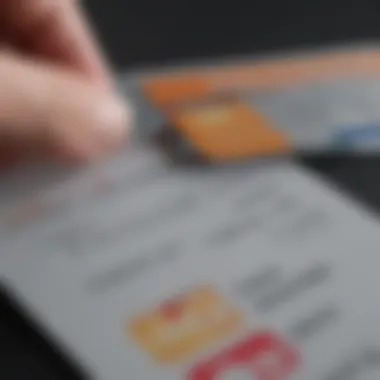How to Access Your Credit Card Balance Effectively


Intro
Keeping tabs on your credit card balance is not just about knowing how much you owe; it's a pivotal aspect of maintaining robust financial health. Most individuals find themselves caught in the whirlwind of spending without ever stopping to check their balance. This guide aims to remedy that, providing practical steps and insightful approaches to access your credit card balance conveniently.
In today's digital age, a myriad of options exist for checking your balance, each with its own advantages. From online banking portals to smartphone applications, the methods available can cater to different preferences and lifestyles. Furthermore, understanding the importance of being aware of your balance transcends mere numbers; it is about fostering responsible spending habits and avoiding pitfalls such as overspending.
This article endeavors to equip you with the knowledge required to stay informed about your credit card balance, enhancing your ability to manage your finances wisely.
Prelims to Credit Card Balances
When it comes to personal finance, understanding your credit card balance is like having a compass in the unpredictable landscape of money management. Not only does it tell you how much debt you’re carrying, but it also crucially informs your spending habits and influences your financial decisions. Knowing your balance can prevent overspending and help you stay within your limits, ultimately ensuring you don’t find yourself knee-deep in a financial mess.
Definition of Credit Card Balance
Credit card balance refers to the total amount of money you owe to your credit card issuer at any given moment. This amount can change daily based on purchases, payments, interest rates, and fees. Each time you swipe that plastic card or make an online purchase, your balance ticks upward. Conversely, every payment you make to your card immediately chips away at that total. Keeping tabs on this number is more than just a best practice; it’s a necessity for anyone who wants to maintain good financial health.
Importance of Checking Your Balance
Regularly checking your credit card balance grants you a front-row seat to your financial reality. Knowing precisely where you stand enables you to:
- Avoid Hidden Trapdoors: Many folks underestimate the danger of an unexpected balance. A quick glance can save you from over-limit fees or, worse, declined purchases when you’re at the cash register.
- Manage Spending Wisely: When you know how much you owe, budgeting becomes a simpler task. You can allocate funds for essentials while leaving room for leisure without breaking the bank.
- Boost Credit Score: Your credit utilization ratio, which is the percentage of your total credit limit that you’re currently using, significantly affects your credit score. Keeping your balance low relative to your limit is favorable in the eyes of creditors.
"Keeping a regular eye on your credit card balance is akin to planting a flag on the summit of your financial landscape; it helps steer you clear of potential pitfalls and lets you savor the view."
Regular balance checks empower you to make informed decisions that align with both short-term needs and long-term financial goals. Whether through digital banking methods, physical statements, or customer service lines, maintaining awareness of your balance is a practice rooted in prudence. It's the first step toward robust financial stewardship.
Common Methods to Find Your Credit Card Balance
Knowing how to find your credit card balance is not just a trivial task; it’s a fundamental skill in today’s financial landscape. Keeping tabs on this number helps in budgeting, preventing overspending, and avoiding the dreaded interest charges that can accrue when balances linger. Understanding the common methods to access your balance equips you with knowledge that can directly influence your financial health.
Online Banking Portals
Many individuals now favor online banking due to its convenience. Logging into your bank’s portal allows you to see not just your current balance, but also transaction history, payment due dates, and more. Each bank’s interface may look a bit different, but the essentials remain the same.
- Security: Most banks implement multiple layers of security to ensure your information is protected. Always check for secure connections (look for the padlock symbol) when you log in.
- Real-Time Updates: Unlike paper statements, accessing your balance online offers real-time visibility. You can see changes as they happen, giving you a clearer picture of your financial standing.
- Comprehensive Insights: Some online portals present data analytics on your spending habits, potentially informing better financial decisions.
Mobile Banking Applications
For those who prefer to manage their finances on-the-go, mobile banking applications have become essential. These apps exist for nearly every financial institution and often replicate the functionality of their web counterparts.
- Easy Accessibility: All it takes is a few taps on your smartphone to check your balance. This immediate access could also save you money by keeping you from making unnecessary purchases.
- Alerts and Notifications: Many apps allow you to set alerts for low balances or due payments, helping you stay proactive rather than reactive when it comes to your finances.
- Budgeting Tools: Some mobile apps seamlessly integrate budgeting tools that can assist in tracking your spending alongside your balance.
ATMs and Card Readers


ATMs are a more traditional method of finding your credit card balance, but they remain relevant. A simple transaction at an ATM can give you the current balance while allowing cash withdrawal.
- Availability: You can find ATMs in supermarkets, convenience stores, and even at stations, making them accessible anytime.
- No Internet Required: If you’re in a spot without internet, you can still get your balance info, which is handy in emergencies.
- Transaction Records: Some ATMs print a mini-statement. This can be a useful method to quickly glance over recent transactions along with your balance.
Customer Service Lines
If technology isn’t your cup of tea, dialing your bank’s customer service can be an effective way to get your balance. While it may not be the fastest method, sometimes talking to a human can provide peace of mind.
- Clarification Needed: Customer service agents can help clarify any confusion about your balance, recent transactions, or even fees that may have caught you off guard.
- No Website Access Required: If you don't have internet access or your app is misbehaving, this is a reliable way to get your numbers.
Monthly Statements
Lastly, the old-fashioned route remains a viable option - the monthly statement. While it might seem cumbersome, familiarizing yourself with your statement can unveil valuable insights.
- Comprehensive Overview: Your statement provides a complete record of all transactions, payments, and any finance charges over the past billing cycle.
- Trends and Patterns: Examining your statements regularly helps identify spending patterns, which could be beneficial in future budgeting.
It’s wise to leverage several methods for finding your balance. By adopting a strategic approach to these various channels, you can take control of your finances in a way that suits your lifestyle.
Understanding Your Credit Card Statement
When it comes to managing your credit cards, understanding your statements is crucial. These documents are a snapshot of your financial activities and they hold a treasure trove of information about your spending habits, payment history, and due dates. Ignoring your statement not only leaves you in the dark about how much you owe but could also lead to financial pitfalls. By dissecting your monthly credit card statement, you can gain insight into your financial health and develop a more disciplined approach to spending.
Components of a Statement
A credit card statement typically includes several key components, each serving a specific purpose. Here are the main elements you should pay attention to:
- Account Summary: This section summarizes your balance, available credit, and the minimum payment due.
- Transaction History: An itemized list of all your purchases, cash advances, and fees during the billing cycle. This part is like a diary of your spending habits. Pay attention to any unexpected charges.
- Payment Information: Displays how much you paid and remaining balance. This section also contains information on what happens if you miss a payment, giving you a heads-up on consequences.
- Fees and Interest: Be mindful of the fees charged, especially those for late payments or exceeding your limit. Understanding interest rates helps you figure out how much extra you’re paying in the long run.
- Rewards Summary: If your card offers rewards, this part shows what you’ve earned. It can also be a motivator to use your card more strategically.
By familiarizing yourself with these components, you can take charge of your financial status and make smart decisions about future spending.
Importance of Statement Dates
Statement dates are more than just arbitrary markers—they are critical for tracking your finances effectively. The statement date indicates when your billing cycle ends. Understanding this date is vital because it determines when you must make your payment to avoid late fees and interest charges.
Here are some reasons statement dates matter:
- Payment Planning: Knowing your statement date allows you to plan your payments strategically, especially if you receive your salary around the same time. This ensures you’re not scrambling at the last minute.
- Monitoring Spending Patterns: If you consistently check your statement soon after its issue, you can better observe patterns in your spending and adjust as needed. This habit can help you stay within budget, avoiding unnecessary debt.
- Interest Charges: The date also marks the cutoff for new purchases to be considered in your next billing cycle. This is crucial because if you make a big purchase right before the statement date, you might end up paying interest if you can’t pay the full balance.
The Role of Available Credit
When discussing credit cards, understanding the concept of available credit is crucial. This metric can profoundly influence your finances, affecting everything from spending habits to credit scores. Your available credit is simply the amount you can still charge on your credit card before reaching the limit. It's calculated by subtracting your current balance from your credit limit. Grasping this concept can help you manage your expenses more effectively and avoid unnecessary fees or potential financial pitfalls.
The significance of keeping an eye on your available credit cannot be overstated. Not only does it give you a clear picture of your purchasing power but it also plays a critical role in maintaining a healthy credit score. Lenders look favorably on borrowers who use less than 30% of their available credit. Consistently exceeding this can signal a higher risk, which could impact your borrowing options down the line.


How Available Credit is Calculated
Let’s break down the calculation of available credit. The formula is straightforward:
Available Credit = Credit Limit - Current Balance
For instance, if your credit limit is $5,000 and your current balance is $2,000, that leaves you with $3,000 in available credit. Clear as day, right? However, this calculation isn’t static. If you rack up charges, your available credit will change in real-time. Similarly, if you make payments, your available credit will increase accordingly.
Understanding how to quickly calculate your available credit can empower you to make informed spending decisions. Keep in mind that it’s not just about avoiding over-the-limit fees but also being smart about how you utilize your credit.
Impact on Spending and Financial Health
The relationship between available credit and your spending patterns isn't just a numbers game; it reflects broader implications for your financial health. When you know exactly how much credit you have available, you can plan your spending more judiciously. This foresight helps in avoiding impulse purchases that could lead you down a slippery slope of debt.
"Management of available credit is crucial because it can mean the difference between comfortable financial planning and uncovering stress at the end of the month."
Moreover, maintaining a healthy balance of available credit is a key component of financial stability. If you find yourself consistently maxing out your credit cards, it could be wise to reevaluate your budget or spending habits. Keeping your balances low relative to your limit can not only reduce interest costs but also improve your credit utilization ratio, which is a major factor in credit scoring models.
Some things to watch out for include:
- High utilization rates can reduce your credit score.
- Paying bills late can impact your available credit and prompt lenders to lower your credit limit.
- A sudden change in your available credit due to a new purchase can lead to anxiety and poor financial decisions.
In summary, understanding your available credit and how it influences spending can lead to more empowered financial choices. Not just for immediate purchases but for long-term financial wellness, it’s a key aspect that shouldn't be overlooked.
Managing Your Credit Card Balance Effectively
Managing a credit card balance isn't just about knowing what you owe; it's about taking charge of your finances in a meaningful way. As individuals navigate their personal finance strategies, understanding how to effectively manage a credit card balance emerges as a vital skill. The right approach to this aspect of money management can help not only in avoiding unnecessary charges but also in building a healthier financial future.
One essential aspect of managing a credit card balance is setting a budget. A well-thought-out budget acts like a compass, guiding your spending and ensuring you remain within limits that you define. Establishing how much you can afford to spend on a credit card helps you avoid the pitfall of overspending. Furthermore, it encourages conscious spending; when every purchase aligns with your budget, you're more intentional about your financial choices.
Setting a Budget
Setting a budget starts with a clear, honest assessment of your income and expenses. Begin by listing all sources of income, including salaries, side hustles, and any other cash flow. Next, evaluate monthly expenditures: rent or mortgage, utilities, groceries, and discretionary items. This step helps in identifying areas where you might be able to cut costs. Consider adopting the 50-30-20 rule—50% of your income on needs, 30% on wants, and 20% on savings and debt repayment.
After you've set your budget, it’s crucial to stick to it. Consider the use of digital tools or apps that can help track your spending in real time. This kind of tracking can illuminate patterns that you might not have noticed otherwise, enabling you to make better choices in the future and, ultimately, stick closer to your budget.
Best Practices for Payment
Once you've set a budget, it's time to think about how to make payments effectively. A common pitfall is only making minimum payments; while it may seem manageable, this often leads to higher accruing interest and prolonged debt. Whenever possible, aim to pay more than the minimum. If you find a little extra cash, seizing the opportunity to apply it to your credit card balance can make a significant difference over time.
Another strategy includes timing your payments. Breaking your payment into bi-weekly installments instead of a single monthly one can mitigate interest accumulation. Each payment chips away at that balance, resulting in potential savings and improving your credit utilization ratio, which can have a positive ripple effect on your credit score.
"Effective payment management not only keeps your balance in check but can also build your credit profile for future opportunities."


Using Alerts and Notifications
Staying informed about your credit card balance can be greatly enhanced by utilizing alerts and notifications. Most credit card companies provide features that let you set up alerts for various activities, from approaching your credit limit to reminders about upcoming payment due dates. It’s a useful layer of protection that prevents any unexpected surprises.
Moreover, these alerts help maintain the discipline necessary for effective financial management. With reminders nudging you here and there, you’re less likely to forget about that payment or overlook your spending limit. You may also set up notifications when your payment is processed, providing another layer of assurance that you are on top of your finances.
In summary, managing your credit card balance takes several forms, from establishing a thoughtful budget to payment strategies and utilizing technology for helpful notifications. By adopting these approaches, you not only improve your financial health but also cultivate habits that can pave the way for future financial stability and growth.
Consequences of Ignoring Your Credit Card Balance
When it comes to managing financial health, being aware of your credit card balance is not just a good habit; it's essential. In today's fast-paced world where expenditures often creep up without notice, overlooking your balance can lead to severe financial repercussions. Ignoring this aspect of personal finance can yield not just immediate monetary costs, but also long-term effects on your creditworthiness and overall financial standing.
Over-Limit Fees and Charges
One primary consequence of neglecting to keep an eye on your credit card balance is the risk of exceeding your credit limit. With many cards, once you surpass this limit, you could incur sizable over-limit fees. These are typically charged each time you make a purchase that puts you over the limit, and can drain your wallet quicker than a leaky faucet. The worst part? Some credit card issuers may automatically deny transactions that exceed your limit, leaving you in a lurch at an inopportune moment, like at the checkout counter of a grocery store or while paying for a much-needed petrol refill.
Understanding how much available credit you have is crucial. For example:
- You might think you have an extra $50 to spend, but if that amount puts you over the limit due to recent purchases that haven’t fully processed yet, you’ll end up with a nasty surprise.
- Over-limit fees can range anywhere from $25 to $40, significantly increasing your debt burden without you even realizing it.
Visualizing this risk may make it easier to manage. But it's not just about the immediate fees; exceeding your credit limit can lead to a cycle of overspending, making it tough to regain control.
Impact on Credit Score
The implications of ignoring your credit card balance extend far beyond your current budget; they also affect your credit score. Your credit score is a reflection of your financial habits, and consistently exceeding your limit can ding your score more than a couple notches. Payment history, credit utilization ratio, and the total amounts owed greatly contribute to your overall score.
- Credit Utilization Ratio: If your card limit is $1,000 and your balance consistently hovers around $900, your utilization rate is 90%. This is considered risky by lenders. Ideally, keeping that rate below 30% keeps you in good standing.
- Long-Term Effects: A lower credit score translates to higher interest rates on loans or even denial of credit in the future. In this economy, that's a tall price to pay.
End
Bringing together the various threads discussed throughout this article really underscores the importance of knowing how to find your credit card balance. This is not just a peripheral aspect of financial management; it’s core for anyone looking to maintain control over their spending and avoid hidden pitfalls that come with credit card usage.
Proactively keeping track of your balance helps in more ways than one. First, you’re better equipped to dodge over-limit fees, which can sneak up on you if you’re not aware of your current standing. Having a grasp on your balance allows you to make informed decisions, ensuring you don’t fall into unintentional debt traps. And as we noted earlier, unintended overspending can have a knock-on effect on your credit score – one bad month could linger and influence your borrowing opportunities down the line.
Another crucial factor is the relationship between budgeting and credit card management. Familiarity with your balance allows you to align your credit card spending with your broader financial goals. This awareness forms a crucial foundation that supports healthy spending habits, leading to more resilient financial behavior.
In sum, checking your credit card balance regularly should be a foundational habit for anyone serious about their finances. Here’s a quick rundown of some essential note:
"Knowledge is power, especially when it comes to managing finances."
Recap of Key Points
- Finding your credit card balance is crucial to avoid over-limit fees and unnecessary debt.
- Regular monitoring can positively impact your credit score by demonstrating responsible credit usage.
- Understanding your balance helps align your spending with budgetary goals, reinforcing healthier financial habits.
Encouraging Proactive Financial Management
Financial management isn’t just about crunching numbers; it’s also about developing a mindset geared towards vigilance and awareness. Encouraging proactive strategies, such as regularly checking your credit card balance, can significantly alter how you approach your finances. Instead of waiting for statements to arrive, make it a routine to check balances after significant purchases. Small habits lead to big changes.
Using alerts to notify you of balances can also keep you in the know without much effort. Most banks offer this feature, which can give you peace of mind every time you near your limit. Keeping good records and being organized ensures you can assess your spending patterns over time and adjust accordingly.
From my experience, cultivating these behaviors pays off in the long run. Not only does it refine your financial literacy, but it also enhances your personal confidence. Taking the initiative to learn and adapt is the cornerstone of effective financial management and sets the stage for achieving your financial goals.







